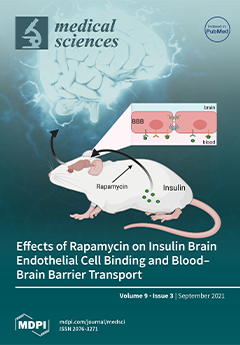Aim: To determine the frequency, mode of transmission, and outcome of Coronavirus Disease 2019 (COVID-19) among healthcare workers (HCWs) in a tertiary care cardiac center in the Kingdom of Saudi Arabia (KSA).
Methods: This is a retrospective study of Severe Acute Respiratory Syndrome
[...] Read more.
Aim: To determine the frequency, mode of transmission, and outcome of Coronavirus Disease 2019 (COVID-19) among healthcare workers (HCWs) in a tertiary care cardiac center in the Kingdom of Saudi Arabia (KSA).
Methods: This is a retrospective study of Severe Acute Respiratory Syndrome Coronavirus 2 (SARS-CoV-2) infected HCWs and was conducted from 2 March to 31 December 2020. Data related to the presence of COVID-19 symptoms, mode of transmission, hospitalization, and mortality were collected from the patients’ medical records.
Results: Of the 4462 patients tested for COVID-19 by real-time reverse transcriptase polymerase chain reaction (RT-PCR), 203 (4.5%) HCWs were positive; of these, 125 (61.6%) were males, and the most common age group was <40 years. The most commonly encountered health professionals were nurses (74, 36.4%), followed by therapists/technicians (48, 23.6%), housekeepers (25, 12.3%), and physicians (21, 10.4%). The majority (184, 90.6%) of the HCWs contracted COVID-19 in the community, and only 19 (9.4%) were healthcare-associated infections. Of the infected HCWs, 169 (83.3%) had mild symptoms and were managed in home isolation. The most common symptoms were fever (128, 63.1%), body ache (124, 61.8%), headache (113, 55.7%), dry cough (123, 60.6%), sore throat (97, 47.8%), body weakness (97, 47.8%), and fatigue (94, 46.3%). Comparing males and females, there was a significantly higher number of female nurses; in contrast, there was a higher number of male physicians, housekeepers, therapists/technicians, and other specialty HCWs. A significantly lower number of nurses, therapists/technicians were infected in the ≥40 years age group compared to <40 years. Furthermore, a significantly higher difference was observed among non-Saudi nurses compared to Saudi nurses. No mortality was documented among the included HCWs.
Conclusions: In the largest tertiary cardiac center in KSA, most HCWs who contracted COVID-19 developed mild symptoms; nurses and those aged <40 years were most commonly infected, and most infections were acquired in the community. HCWs’ adherence to mitigation measures outside of the workplace is vital to curb the current pandemic and decrease nosocomial transmission risk.
Full article




